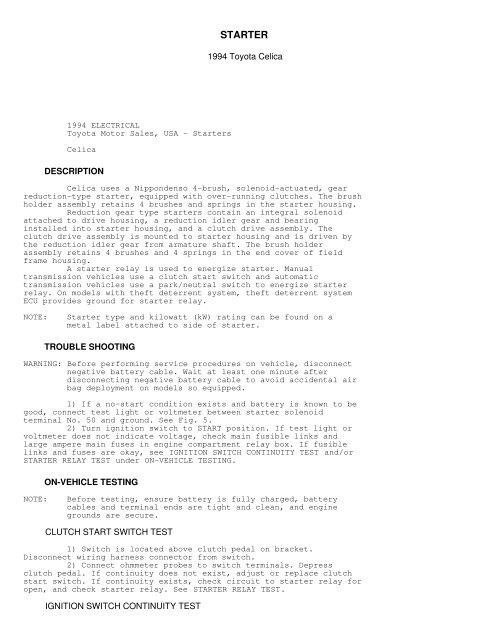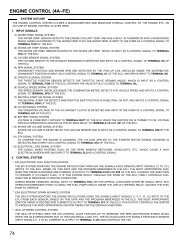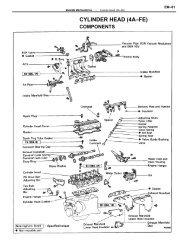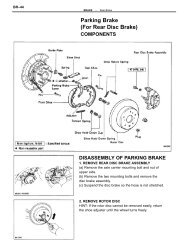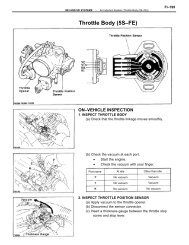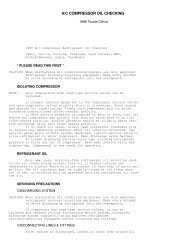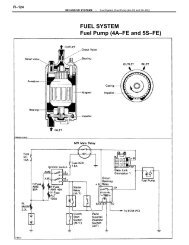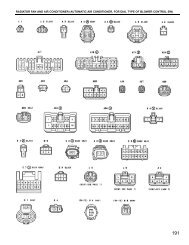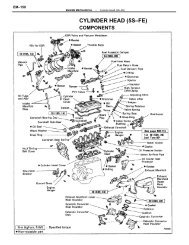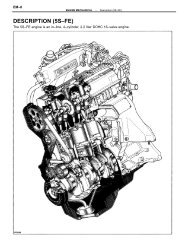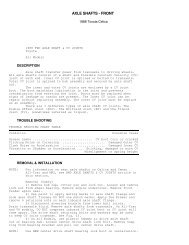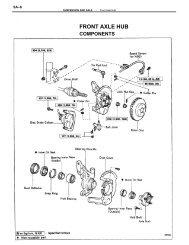Starters - CelicaTech
Starters - CelicaTech
Starters - CelicaTech
Create successful ePaper yourself
Turn your PDF publications into a flip-book with our unique Google optimized e-Paper software.
STARTER<br />
1994 Toyota Celica<br />
1994 ELECTRICAL<br />
Toyota Motor Sales, USA - <strong>Starters</strong><br />
Celica<br />
DESCRIPTION<br />
Celica uses a Nippondenso 4-brush, solenoid-actuated, gear<br />
reduction-type starter, equipped with over-running clutches. The brush<br />
holder assembly retains 4 brushes and springs in the starter housing.<br />
Reduction gear type starters contain an integral solenoid<br />
attached to drive housing, a reduction idler gear and bearing<br />
installed into starter housing, and a clutch drive assembly. The<br />
clutch drive assembly is mounted to starter housing and is driven by<br />
the reduction idler gear from armature shaft. The brush holder<br />
assembly retains 4 brushes and 4 springs in the end cover of field<br />
frame housing.<br />
A starter relay is used to energize starter. Manual<br />
transmission vehicles use a clutch start switch and automatic<br />
transmission vehicles use a park/neutral switch to energize starter<br />
relay. On models with theft deterrent system, theft deterrent system<br />
ECU provides ground for starter relay.<br />
NOTE: Starter type and kilowatt (kW) rating can be found on a<br />
metal label attached to side of starter.<br />
TROUBLE SHOOTING<br />
WARNING: Before performing service procedures on vehicle, disconnect<br />
negative battery cable. Wait at least one minute after<br />
disconnecting negative battery cable to avoid accidental air<br />
bag deployment on models so equipped.<br />
1) If a no-start condition exists and battery is known to be<br />
good, connect test light or voltmeter between starter solenoid<br />
terminal No. 50 and ground. See Fig. 5.<br />
2) Turn ignition switch to START position. If test light or<br />
voltmeter does not indicate voltage, check main fusible links and<br />
large ampere main fuses in engine compartment relay box. If fusible<br />
links and fuses are okay, see IGNITION SWITCH CONTINUITY TEST and/or<br />
STARTER RELAY TEST under ON-VEHICLE TESTING.<br />
ON-VEHICLE TESTING<br />
NOTE: Before testing, ensure battery is fully charged, battery<br />
cables and terminal ends are tight and clean, and engine<br />
grounds are secure.<br />
CLUTCH START SWITCH TEST<br />
1) Switch is located above clutch pedal on bracket.<br />
Disconnect wiring harness connector from switch.<br />
2) Connect ohmmeter probes to switch terminals. Depress<br />
clutch pedal. If continuity does not exist, adjust or replace clutch<br />
start switch. If continuity exists, check circuit to starter relay for<br />
open, and check starter relay. See STARTER RELAY TEST.<br />
IGNITION SWITCH CONTINUITY TEST
¡ ¡ ¡ ¡ ¡ ¡ ¡ ¡ ¡ ¡ ¡ ¡ ¡ ¡ ¡ ¡ ¡ ¡ ¡ ¡ ¡ ¡ ¡ ¡ ¡ ¡ ¡ ¡ ¡ ¡ ¡ ¡ ¡ ¡ ¡ ¡ ¡ ¡ ¡ ¡ ¡ ¡ ¡ ¡ ¡ ¡ ¡ ¡ ¡ ¡ ¡ ¡ ¡ ¡ ¡ ¡ ¡ ¡ ¡<br />
1) Disconnect negative battery cable. Remove driver’s lower<br />
instrument panel cover. Remove upper and lower steering column covers<br />
if needed. Locate ignition switch wiring harness 8-pin connector. See<br />
Fig. 1.<br />
2) With ignition switch in LOCK position, there should be no<br />
continuity between any terminals. With ignition switch in ACC<br />
position, there should be continuity between terminals No. 5 and 7.<br />
With ignition switch in ON position, there should be continuity<br />
between terminals No. 2 and 3, and between terminals No. 4, 5 and 7.<br />
With ignition switch in START position, there should be continuity<br />
between terminals No. 1, 2 and 3, and between terminals No. 4, 7 and<br />
8. If continuity is not as specified, replace switch.<br />
Fig. 1: Identifying Ignition Switch 8-Pin Connector<br />
Courtesy of Toyota Motor Sales, U.S.A., Inc.<br />
PARK/NEUTRAL SWITCH<br />
NOTE:<br />
If vehicle will not start with shift lever in Park/Neutral<br />
position, verify correct park/neutral switch adjustment. If<br />
park/neutral switch is correctly adjusted, verify switch<br />
continuity.<br />
PARK/NEUTRAL SWITCH CONTINUITY SPECIFICATIONS<br />
¡¡¡¡¡¡¡¡¡¡¡¡¡¡¡¡¡¡¡¡¡¡¡¡¡¡¡¡¡¡¡¡¡¡¡¡¡¡¡¡¡¡¡¡¡¡¡¡¡¡¡¡¡¡¡¡¡¡<br />
¡<br />
Gearshift Position Continuity Between Terminals<br />
Park ........................................ 5 & 6, 4 & 7<br />
Reverse ............................................ 4 & 8<br />
Neutral .................................... 5 & 6, 4 & 10<br />
Drive .............................................. 4 & 9<br />
2 .................................................. 2 & 4<br />
Low ................................................ 3 & 4
Fig. 2: Identifying Park/Neutral Switch Terminals<br />
Courtesy of Toyota Motor Sales, U.S.A., Inc.<br />
Adjusting Park/Neutral Switch<br />
Locate park/neutral switch at transmission or transaxle.<br />
Loosen park/neutral position switch bolt(s) and verify shift selector<br />
is in "N" position. Align switch shaft groove with neutral basic line<br />
on switch. Hold switch in position and tighten switch bolt(s) to 48<br />
INCH lbs. (5.4 N.m).<br />
Park/Neutral Switch Continuity Check<br />
Disconnect electrical connector from park/neutral switch at<br />
transmission or transaxle. Using ohmmeter, check for continuity at<br />
specified terminals with gearshift in proper positions. See Fig. 2.<br />
See PARK/NEUTRAL SWITCH CONTINUITY SPECIFICATIONS table. Replace<br />
switch if defective.<br />
STARTER RELAY TEST<br />
Starter Relay<br />
1) Locate and remove starter relay. See<br />
STARTER RELAY LOCATION table. See Fig. 4. Using ohmmeter, verify<br />
continuity between relay terminals No. 1 and 2. See Fig. 3. Continuity<br />
should not exist between terminals No. 3 and 5. If continuity is not<br />
as indicated, replace relay.<br />
2) Check relay operation by applying battery voltage through<br />
terminals No. 1 and 2. See Fig. 3. Continuity should now exist between<br />
terminals No. 3 and 5. If relay does not test as indicated, replace<br />
relay.
¡ ¡ ¡ ¡ ¡ ¡ ¡ ¡ ¡ ¡ ¡ ¡ ¡ ¡ ¡ ¡ ¡ ¡ ¡ ¡ ¡ ¡ ¡ ¡ ¡ ¡ ¡ ¡ ¡ ¡ ¡ ¡ ¡ ¡ ¡ ¡ ¡ ¡ ¡ ¡ ¡ ¡ ¡ ¡ ¡ ¡ ¡ ¡ ¡ ¡ ¡ ¡ ¡ ¡ ¡ ¡ ¡ ¡ ¡<br />
Fig. 3: Testing Starter Relay<br />
Courtesy of Toyota Motor Sales, U.S.A., Inc.<br />
Fig. 4: Locating Starter Relay<br />
Courtesy of Toyota Motor Sales, U.S.A., Inc.<br />
STARTER RELAY LOCATION
¡ ¡ ¡ ¡ ¡ ¡ ¡ ¡ ¡ ¡ ¡ ¡ ¡ ¡ ¡ ¡ ¡ ¡ ¡ ¡ ¡ ¡ ¡ ¡ ¡ ¡ ¡ ¡ ¡ ¡ ¡ ¡ ¡ ¡ ¡ ¡ ¡ ¡ ¡ ¡ ¡ ¡ ¡ ¡ ¡ ¡ ¡ ¡ ¡ ¡ ¡ ¡ ¡ ¡ ¡ ¡ ¡ ¡ ¡<br />
¡ ¡ ¡ ¡ ¡ ¡ ¡ ¡ ¡ ¡ ¡ ¡ ¡ ¡ ¡ ¡ ¡ ¡ ¡ ¡ ¡ ¡ ¡ ¡ ¡ ¡ ¡ ¡ ¡ ¡ ¡ ¡ ¡ ¡ ¡ ¡ ¡ ¡ ¡ ¡ ¡ ¡ ¡ ¡ ¡ ¡ ¡ ¡ ¡ ¡ ¡ ¡ ¡ ¡ ¡ ¡ ¡ ¡ ¡<br />
Application<br />
Location<br />
Celica ................... In Engine Compartment Relay Box<br />
BENCH TESTING<br />
NO-LOAD TEST<br />
CAUTION: DO NOT engage starter solenoid for more than 5 seconds<br />
during testing, or damage to coil winding will result.<br />
NO-LOAD TEST SPECIFICATIONS<br />
¡ ¡ ¡ ¡ ¡ ¡ ¡ ¡ ¡ ¡ ¡ ¡ ¡ ¡ ¡ ¡ ¡ ¡ ¡ ¡ ¡ ¡ ¡ ¡ ¡ ¡ ¡ ¡ ¡ ¡ ¡ ¡ ¡ ¡ ¡ ¡ ¡ ¡ ¡ ¡ ¡ ¡ ¡ ¡ ¡ ¡ ¡ ¡ ¡ ¡ ¡ ¡ ¡ ¡ ¡ ¡ ¡ ¡ ¡<br />
Application Maximum Amps @ (Volts) RPM<br />
1.4 kW ..................... 90 (11.5) ............ 3000<br />
1.6 kW ..................... 90 (11.5) ............ 3000<br />
1) Remove starter. Connect ammeter in series between starter<br />
motor terminal No. 30 (battery terminal) and a fully charged 12-volt<br />
battery. Connect battery negative to starter case ground. See Fig. 5.<br />
Connect voltmeter to battery to observe voltage draw readings.<br />
2) Connect remote starter or jumper wire to terminal No. 30<br />
and to terminal No. 50 to engage starter. Starter drive pinion gear<br />
should extend quickly and spin smoothly. Verify starter amperage draw<br />
and battery voltage draw to be within specifications. See<br />
NO-LOAD TEST SPECIFICATIONS table. Replace starter if not within<br />
specification.<br />
Fig. 5: Testing Starter No-Load (Reduction Gear)<br />
Courtesy of Toyota Motor Sales, U.S.A., Inc.<br />
SOLENOID TESTS
CAUTION: DO NOT engage starter solenoid for more than 5 seconds<br />
during testing, or damage to coil winding will result.<br />
Pull-In Coil Test<br />
Disconnect field coil lead from terminal "C". Connect jumper<br />
wires from negative battery terminal to terminal "C" and to starter<br />
housing. When wire is connected from positive battery terminal to<br />
terminal No. 50, clutch pinion gear should extend fully. See Fig. 6.<br />
If clutch pinion gear does not move, replace solenoid. If clutch<br />
pinion gear does move, go to next test.<br />
Hold-In Coil Test<br />
With battery connected as in previous test and clutch pinion<br />
gear still extended, disconnect jumper wire from starter terminal "C".<br />
See Fig. 7. Clutch pinion gear should remain extended. If clutch<br />
pinion gear does not remain extended, replace solenoid. If clutch<br />
pinion gear does remain extended, go to next test.<br />
Drive Pinion Return Test<br />
Disconnect jumper wire from negative battery terminal to<br />
starter housing. See Fig. 8. Pinion gear should now retract. If it<br />
does not retract, replace solenoid.<br />
STARTER COMPONENT INSPECTION<br />
Armature Coil<br />
1) Using ohmmeter, check for continuity between armature coil<br />
core and insulation between commutator segments. If continuity is<br />
present, replace armature. Check armature for shorts using a growler.<br />
Replace armature as necessary.<br />
2) Check for continuity between segments of commutator. If<br />
continuity is not present between any segment, replace armature.<br />
Fig. 6: Solenoid Pull-In Coil Test<br />
Courtesy of Toyota Motor Sales, U.S.A., Inc.
Fig. 7: Solenoid Hold-In Coil Test<br />
Courtesy of Toyota Motor Sales, U.S.A., Inc.<br />
Fig. 8: Solenoid Drive Pinion Return Test<br />
Courtesy of Toyota Motor Sales, U.S.A., Inc.<br />
Brushes & Springs<br />
1) Check brush length. If length is less than specification,
eplace brushes. See NIPPONDENSO STARTER SPECIFICATIONS table under<br />
STARTER SPECIFICATIONS.<br />
2) Check brush holders, springs, spring clip and insulation<br />
between positive and negative holders. Verify no continuity exists<br />
between positive and negative brush holders. Repair or replace<br />
components as needed.<br />
Clutch Assembly & Gears<br />
1) Inspect teeth on pinion gear, idler gear and clutch<br />
assembly for wear or damage. If damaged, replace gear or clutch<br />
assembly and inspect flywheel ring gear for wear or damage.<br />
2) Inspect clutch pinion gear by rotating pinion gear.<br />
Depending on engine, pinion gear will rotate freely in one direction<br />
and lock when rotated in opposite direction. Clutch pinion gear will<br />
lock when rotated in a clockwise direction. If necessary, replace<br />
clutch assembly.<br />
Commutator<br />
1) If commutator surface is dirty or burnt, it can be cleaned<br />
with No. 400 grit sandpaper or on a lathe. If commutator runout (outof-round)<br />
is more than .002" (.05 mm), turn commutator on a lathe.<br />
Wear or cutting limit of commutator diameter is 1.14" (29.0 mm) for 1.<br />
4 and 1.6 kW starter. If commutator diameter is less than minimum,<br />
replace armature.<br />
2) Ensure undercut depth between commutator segments are<br />
clean, free of debris, and that edges are smooth. Minimum undercut<br />
depth is .008" (.20 mm). If undercut depth is less than minimum, use a<br />
hacksaw blade to correct to a depth of .008-.024" (.20-.60 mm).<br />
Field Frame (Field Coil)<br />
Verify continuity between lead wire and field coil brush<br />
lead. If continuity is not present, replace field coil. Verify there<br />
is no continuity between field coil end and field frame. If continuity<br />
exits, replace or repair field frame.<br />
REMOVAL & INSTALLATION<br />
STARTER MOTOR<br />
Removal & Installation (7A-FE)<br />
1) Disconnect negative battery cable. Disconnect intake air<br />
temperature sensor and accelerator cable from clamp on air cleaner<br />
hose. Disconnect cruise control actuator cable from clamp on air<br />
cleaner hose (if equipped). Remove vacuum hose (from port "P" of<br />
throttle body) from air cleaner hose.<br />
2) Disconnect 4 clamps, and disconnect air cleaner cap from<br />
air cleaner case. Loosen hose clamp, and disconnect air cleaner hose<br />
from throttle body. Remove air cleaner cap and air cleaner hose<br />
assembly.<br />
3) Remove bolt, and disconnect wire clamp from transaxle.<br />
Disconnect starter connector. Remove nut, and disconnect starter<br />
cable. Remove 2 bolts and starter. To install, reverse removal<br />
procedure. Tighten starter mounting bolts to 29 ft. lbs. (39 N.m).<br />
Removal & Installation (5S-FE, With Cruise Control)<br />
1) Disconnect negative battery cable. Disconnect air intake<br />
temperature sensor connector from air cleaner assembly. On California<br />
models, remove spark plug wire from air cleaner hose. On all models,<br />
remove cruise control actuator cable from clamps.<br />
2) On California models, remove air hose for idle-up from air<br />
cleaner hose. On all models, disconnect 4 clamps, and disconnect air<br />
cleaner cap from air cleaner case. Loosen hose clamp, and disconnect
air cleaner hose from throttle body.<br />
3) Remove air cleaner cap and air cleaner hose assembly.<br />
Remove air filter. Disconnect 2 engine wires from clamps on air<br />
cleaner case. Remove 3 bolts and air cleaner case. Remove battery.<br />
Disconnect cruise control actuator connector.<br />
4) Remove 3 bolts, and disconnect actuator from body bracket.<br />
Disconnect starter connector. Remove nut, and disconnect starter<br />
cable. Remove 2 bolts, and disconnect O2 sensor connector and engine<br />
wire brackets from starter. Remove starter. To install, reverse<br />
removal procedure. Tighten starter mounting bolts to 29 ft. lbs. (39<br />
N.m).<br />
Removal & Installation (5S-FE, Without Cruise Control)<br />
1) Disconnect negative battery cable. Disconnect air intake<br />
temperature sensor connector from air cleaner assembly. On California<br />
models, remove spark plug wire from air cleaner hose.<br />
2) On California models, remove air hose for idle-up from air<br />
cleaner hose. On all models, disconnect 4 clamps, and disconnect air<br />
cleaner cap from air cleaner case. Loosen hose clamp, and disconnect<br />
air cleaner hose from throttle body.<br />
3) Remove air cleaner cap and air cleaner hose assembly.<br />
Remove air filter. Disconnect 2 engine wires from clamps on air<br />
cleaner case. Remove 3 bolts and air cleaner case. Disconnect starter<br />
connector. Remove nut, and disconnect starter cable.<br />
4) Remove 2 bolts, and disconnect O2 sensor connector and<br />
engine wire brackets from starter. Remove starter. To install, reverse<br />
removal procedure. Tighten starter mounting bolts to 29 ft. lbs. (39<br />
N.m).<br />
OVERHAUL<br />
NOTE:<br />
Overhaul procedures are not available from manufacturer. For<br />
exploded views of starters, see Fig. 9.<br />
Fig. 9: Exploded View Of Gear Reduction Starter<br />
Courtesy of Toyota Motor Sales, U.S.A., Inc.<br />
STARTER SPECIFICATIONS
¡ ¡ ¡ ¡ ¡ ¡ ¡ ¡ ¡ ¡ ¡ ¡ ¡ ¡ ¡ ¡ ¡ ¡ ¡ ¡ ¡ ¡ ¡ ¡ ¡ ¡ ¡ ¡ ¡ ¡ ¡ ¡ ¡ ¡ ¡ ¡ ¡ ¡ ¡ ¡ ¡ ¡ ¡ ¡ ¡ ¡ ¡ ¡ ¡ ¡ ¡ ¡ ¡ ¡ ¡ ¡ ¡ ¡ ¡<br />
¡ ¡ ¡ ¡ ¡ ¡ ¡ ¡ ¡ ¡ ¡ ¡ ¡ ¡ ¡ ¡ ¡ ¡ ¡ ¡ ¡ ¡ ¡ ¡ ¡ ¡ ¡ ¡ ¡ ¡ ¡ ¡ ¡ ¡ ¡ ¡ ¡ ¡ ¡ ¡ ¡ ¡ ¡ ¡ ¡ ¡ ¡ ¡ ¡ ¡ ¡ ¡ ¡ ¡ ¡ ¡ ¡ ¡ ¡<br />
NIPPONDENSO STARTER SPECIFICATIONS<br />
¡¡¡¡¡¡¡¡¡¡¡¡¡¡¡¡¡¡¡¡¡¡¡¡¡¡¡¡¡¡¡¡¡¡¡¡¡¡¡¡¡¡¡¡¡¡¡¡¡¡¡¡¡¡¡¡¡¡<br />
¡<br />
Application<br />
Specification<br />
Brush Minimum Length ..................... .394" (10.0 mm)<br />
Brush Spring Load ................. 3.9-5.3 Lbs. (18-24 N)<br />
Commutator<br />
Minimum Diameter ....................... 1.14" (29.0 mm)<br />
Minimum Undercut Depth ................... .008" (.2 mm)<br />
Runout .................................. .002" (.05 mm)<br />
Armature<br />
Core Runout ............................. .002" (.05 mm)<br />
End Play ................................ .002" (.05 mm)<br />
TORQUE SPECIFICATIONS<br />
TORQUE SPECIFICATIONS<br />
¡¡¡¡¡¡¡¡¡¡¡¡¡¡¡¡¡¡¡¡¡¡¡¡¡¡¡¡¡¡¡¡¡¡¡¡¡¡¡¡¡¡¡¡¡¡¡¡¡¡¡¡¡¡¡¡¡¡<br />
¡<br />
Application<br />
Ft. Lbs. (N.m)<br />
Lower Crossmember Bolts (7A-FE) ................ 112 (152)<br />
Starter Mounting Bolts (All Models) .............. 29 (39)<br />
WIRING DIAGRAMS
Fig. 10: Starting System Wiring Diagram (A/T)
Fig. 11: Starting System Wiring Diagram (M/T)


